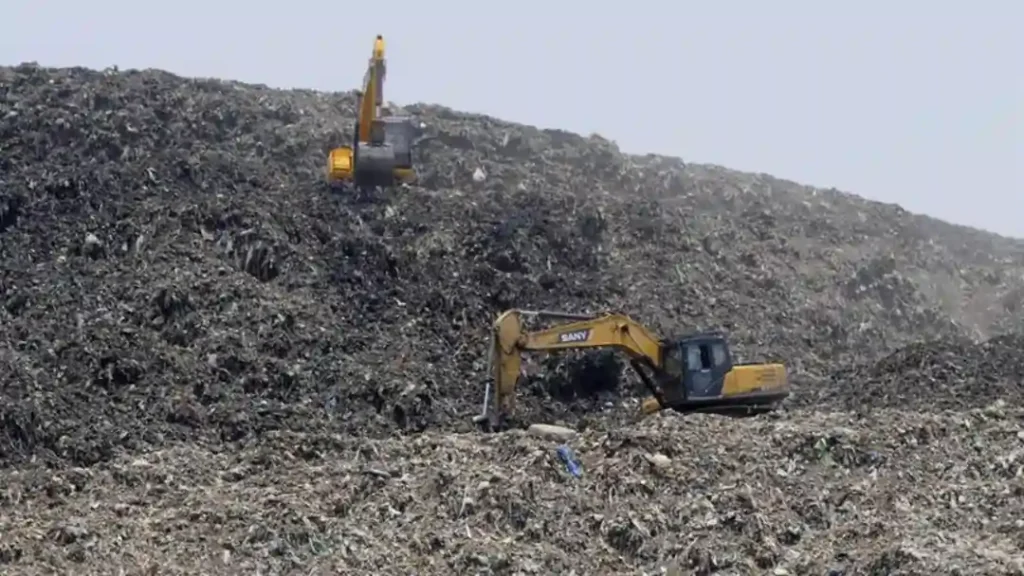New Delhi: In a landmark move to transform urban India into cleaner, greener, and investment-ready spaces, Union Minister for Housing and Urban Affairs Manohar Lal Khattar unveiled the Dumpsite Remediation Accelerator Programme (DRAP) at the National Urban Conclave 2025. This year-long, mission-mode initiative under Swachh Bharat Mission-Urban 2.0 aims to eradicate legacy dumpsites nationwide, targeting the ambitious Lakshya Zero Dumpsites goal by September 2026. Paired with the newly introduced Urban Investment Window (UWIN), these programs signal a robust push toward sustainable urban development under the Viksit Bharat @2047 vision.

DRAP: A Targeted Strike Against India’s Legacy Waste Crisis
DRAP emerges as a high-priority accelerator designed to tackle approximately 8.8 crore metric tonnes (MT) of legacy waste concentrated in high-impact locations. Legacy waste, defined as aged municipal solid waste accumulated in landfills or dumpsites, comprises a complex mix of partially or fully decomposed biodegradable materials, plastic waste, and other refuse. Shockingly, about 80% of this massive burden is confined to just 214 sites spread across 202 Urban Local Bodies (ULBs), making them the focal points for immediate intervention.
The programme operates under the Ministry of Housing and Urban Affairs (MoHUA) and extends eligibility to all States and Union Territories (UTs) with ongoing legacy waste projects. Priority is given to sites holding over 45,000 MT of legacy waste, though no minimum threshold applies for UTs and North Eastern States, ensuring inclusive coverage even in challenging terrains.
Nationwide dumpsite management statistics paint a picture of steady but accelerated progress. Currently, 1,428 sites are actively undergoing remediation, with 1,048 already fully remediated. This leaves a critical backlog, including major emitters of environmental hazards. Primary concerns include leachate – the polluted water that seeps from the base of dumpsite waste, contaminating groundwater and soil – and landfill gas, a potent mixture of carbon dioxide and methane generated under anaerobic decomposition conditions in these sites.
To drive DRAP forward, the government has sanctioned ₹3,000 crore specifically for remediation efforts. The initiative follows a comprehensive 5P framework: Political leadership, Public finance, Public advocacy, Project management, and Partnerships. Cities must develop detailed micro-action plans for each site, with real-time progress tracking via a dedicated DRAP portal. Post-clearance mandates include preventing any fresh waste tipping and repurposing reclaimed land for public or community benefits, such as green zones or parks.
Bhalswa Landfill: A Model of Rapid Remediation Success
Highlighting DRAP’s potential, Delhi’s Bhalswa landfill stands out as an early success story. Minister Khattar personally adopted the site on September 17, 2025, to oversee operations closely. Between September 17 and November 6, an impressive 4.79 lakh tonnes of waste were remediated – a feat that demonstrates the impact of hands-on political oversight and efficient local problem-solving.
Projections for Bhalswa are even more promising: the site is slated to clear 40 lakh cubic metres of waste by October 2026, reclaiming nearly 70 acres of prime urban land. Khattar emphasized this achievement during the launch, urging elected representatives and civic leaders nationwide to “adopt” dumpsites in their areas. He advocated leveraging Corporate Social Responsibility (CSR) funds, private organizations, and state agencies to bolster remediation efforts.
Larger dumpsites like Ghazipur and Bhalswa in Delhi, along with Deonar in Mumbai, will receive prioritized attention due to their enormous scale and associated local challenges. Khattar stressed the necessity of remediating these high-volume sites within a compressed timeline to meet the 2026 national target, underscoring stronger political commitment at every level.
Financial Backbone and Nationwide Progress Under SBM-U 2.0
Swachh Bharat Mission-Urban (SBM-U) 2.0, launched in 2021, forms the foundational umbrella for DRAP. Its core objectives include achieving Garbage Free Status for all cities, full remediation of legacy dumpsites, and their conversion into green zones. Central financial assistance stands at ₹550 per tonne for waste remediation.
To date, ₹4,181 crore has been disbursed, unlocking projects valued at ₹10,228 crore. This support has benefited 2,484 ULBs across 28 states and UTs. On the ground, out of 2,476 identified dumpsites, 1,048 have been completely cleared, resulting in the removal of roughly 25 crore tonnes of legacy waste. Over 7,580 acres of urban land have been reclaimed and repurposed for civic amenities, including public parks and community infrastructure.
The deadline for complete clearance of remaining sites is firmly set between September and October 2026. Cities are mandated to ensure no fresh waste is added post-remediation, aligning with broader goals of sustainable waste management.
UWIN: Bridging the Urban Funding Gap for Infrastructure Growth
Complementing DRAP, the Urban Investment Window (UWIN) was rolled out simultaneously to address India’s staggering urban development needs. Operated by the Housing and Urban Development Corporation (HUDCO), a public sector undertaking under MoHUA, UWIN repurposes HUDCO’s 20 regional offices into specialized hubs. These facilitate cities from project identification through to investment mobilization.
India faces an estimated ₹70,000 crore requirement for urban infrastructure until 2047. UWIN tackles this by helping urban local bodies craft bankable proposals, enhance access to municipal bonds and concessional multilateral financing, structure Public-Private Partnerships (PPPs), and connect with domestic and global investors.
Key focus sectors include solid waste management, urban mobility, water and sewerage systems, and climate-resilient infrastructure. By channeling long-term, low-cost finance from institutions like the World Bank and Asian Development Bank (ADB), UWIN aims to create self-sustaining urban ecosystems that attract private capital.
The 5P Framework in Action: Leadership, Funding, and Collaboration
DRAP’s operational blueprint revolves around the 5P model:
- Political Leadership: Encouraging adoption of sites by leaders, as exemplified by Khattar’s Bhalswa initiative.
- Public Finance: ₹3,000 crore allocation, plus per-tonne incentives and disbursed funds.
- Public Advocacy: Raising awareness to prevent fresh dumping and promote community involvement.
- Project Management: Micro-action plans and the DRAP portal for real-time monitoring.
- Partnerships: Integrating CSR, private sector, and state resources.
This multifaceted approach ensures accountability, transparency, and scalability, with priority for mega-sites contributing the bulk of emissions and land occupation.
Environmental and Health Imperatives Driving the Initiative
Dumpsites pose severe risks through leachate pollution, which threatens water bodies and aquifers, and landfill gases that exacerbate greenhouse emissions and fire hazards. Methane, a key component, is 25 times more potent than carbon dioxide in trapping heat. Remediation not only mitigates these but also unlocks land for productive uses, enhancing urban livability.
Viksit Bharat @2047: DRAP and UWIN as Pillars of Urban Transformation
Together, DRAP and UWIN embody India’s commitment to Viksit Bharat @2047 – a vision for developed, inclusive, and sustainable nationhood. By clearing 245 legacy waste dump sites, including the 214 high-load ones, DRAP paves the way for cleaner cities. UWIN ensures the financial muscle for ongoing and future projects, fostering investment-ready urban landscapes.
Progress metrics are encouraging: 25 crore tonnes remediated, 7,580 acres reclaimed, and thousands of ULBs empowered. Yet, the road to zero dumpsites demands unwavering execution. With political will, innovative funding, and public-private synergy, India is poised to eliminate its legacy waste burden, setting a global benchmark in urban sanitation and renewal.
Key Takeaways on DRAP and UWIN Implementation
- Target Sites: 214 high-load locations with 8.8 crore MT waste (80% of total).
- Eligibility Criteria: Priority for >45,000 MT sites; no threshold for UTs/North East.
- Funding Details: ₹550/tonne; ₹4,181 crore disbursed for ₹10,228 crore projects.
- Progress Snapshot: 1,048/2,476 sites cleared; 1,428 under remediation.
- Bhalswa Milestone: 4.79 lakh tonnes in 50 days; 70 acres by 2026.
- UWIN Role: HUDCO-led; PPPs, bonds, multilateral ties for ₹70,000 crore needs.
As India marches toward Lakshya Zero Dumpsites, DRAP and UWIN represent not just policy tools but catalysts for a greener, more prosperous urban future. Stakeholders from ULBs to global investors are called to action in this defining chapter of Swachh Bharat.
FAQs
1. What is DRAP (Dumpsite Remediation Accelerator Programme) launched by the Indian government?
Answer:
DRAP is a year-long, mission-mode initiative under Swachh Bharat Mission-Urban 2.0, launched on November 9, 2025, by Union Minister Manohar Lal Khattar at the National Urban Conclave 2025. It aims to fast-track the remediation of 245 legacy dumpsites, including 214 high-load sites holding 8.8 crore metric tonnes (MT) of legacy waste — nearly 80% of India’s total dumpsite burden. The goal is Lakshya Zero Dumpsites by September 2026, converting polluted landfills into green zones and public spaces.
2. How much progress has been made in clearing legacy dumpsites in India as of November 2025?
Answer:
As of November 2025:
₹4,181 crore disbursed, supporting projects worth ₹10,228 crore across 2,484 Urban Local Bodies (ULBs) in 28 states/UTs.
1,048 out of 2,476 dumpsites have been fully remediated.
1,428 sites are currently under active remediation.
25 crore tonnes of legacy waste removed.
Over 7,580 acres of urban land reclaimed for parks, community spaces, and infrastructure.
3. What is the 5P framework used in DRAP for dumpsite cleanup?
Answer:
DRAP operates on a 5P strategic framework:
Partnerships – Use of CSR funds, private sector, and state agencies for faster execution.
Political Leadership – Elected leaders “adopt” sites (e.g., Minister Khattar adopted Bhalswa landfill).
Public Finance – ₹3,000 crore allocated + ₹550 per tonne central incentive.
Public Advocacy – Awareness to stop fresh dumping and involve communities.
Project Management – Micro-action plans and real-time DRAP portal for monitoring.
3. What is the 5P framework used in DRAP for dumpsite cleanup?
Answer:
DRAP operates on a 5P strategic framework:
Partnerships – Use of CSR funds, private sector, and state agencies for faster execution.
Political Leadership – Elected leaders “adopt” sites (e.g., Minister Khattar adopted Bhalswa landfill).
Public Finance – ₹3,000 crore allocated + ₹550 per tonne central incentive.
Public Advocacy – Awareness to stop fresh dumping and involve communities.
Project Management – Micro-action plans and real-time DRAP portal for monitoring.
4. What is the Urban Investment Window (UWIN) and how does it support Indian cities?
Answer:
UWIN is a centralized funding platform launched alongside DRAP and managed by HUDCO (Housing and Urban Development Corporation). It helps cities access long-term, low-cost capital for urban infrastructure by:
- Preparing bankable project proposals
- Unlocking municipal bonds and multilateral financing (World Bank, ADB)
- Structuring Public-Private Partnerships (PPPs)
- Connecting ULBs with domestic and global investors
Focus areas: solid waste management, urban mobility, water & sewerage, climate-resilient infrastructure. It addresses India’s ₹70,000 crore urban funding need till 2047.
5. How is Delhi’s Bhalswa landfill being used as a model under DRAP?
Answer:
Bhalswa landfill, one of India’s largest dumpsites, was adopted by Minister Manohar Lal Khattar on September 17, 2025. Key achievements:
- 4.79 lakh tonnes of waste cleared in just 50 days (Sept 17 – Nov 6).
- Full target: 40 lakh cubic metres to be remediated by October 2026.
- Expected outcome: 70 acres of land reclaimed for public use.
This rapid progress showcases political oversight, local coordination, and technology-driven remediation as a replicable model for other major sites like Ghazipur (Delhi) and Deonar (Mumbai).

